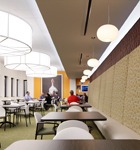A dark workspace is an unhealthy workspace, and Aflac’s executive management and board of directors knew it well. Although the past 20 years have seen the insurance company making a push toward eco-friendly practices—including reducing energy consumption by more than 30 percent per square foot in its offices—a significant renovation of the company’s customer service center (CSC) would be the most dramatic effort to date. The work performed centered on giving employees access to the building’s windows and views, creating healthier indoor air quality, and reducing energy consumption by more than 40 percent. Here’s how the company did it.
Backgrounder/
Viewing LEED as the most widely accepted benchmark for green buildings, Aflac’s facilities team decided to renovate the CSC to LEED-CI standards, explains Alfred Blackmar, vice president of facilities support, and providing rooms with views for more of its employees would be central to the renovation and would also help the firm gain points toward its LEED-CI goal. “We thought that by locating the set offices on the interior of the space, we would able to democratize the daylight and views to the outside for all,” Blackmar says. “This strategy is proven to improve occupant health and comfort while reducing lighting requirements and energy use.” What Aflac didn’t take into account was that moving the outside offices in would also alter long-standing employee dynamics.

Aflac's update to the Customer Service Center provides employees with bright, modern interior spaces crafted from healthful materials. Photo: Christopher Barrett.

Aflac's renovated building takes health seriously, using low- and no-VOC finishes and offering employees a fitness center. Photo: Christopher Barrett.

The center also includes occupancy sensors, low-flow fixtures, and Energy Star appliances. Photo: Christopher Barrett.
Challenge/
Outside the challenges inherent in renovating a building that needed to remain partially occupied during construction, CSC’s greatest obstacle was the shifting of office culture. All offices from the perimeter walls had to be moved to the interior of the building, and the height of the systems furniture was to be lowered to create a more open workplace.
Solution/
“We exercised patience—as we knew people adapt to change at varying speeds—and provided as much assistance as possible in answering questions about the new environment,” Blackmar says. “It wasn’t always easy, but eventually all Aflac personnel understood that moving offices to the building’s center and lowering height of systems furniture walls would enable everyone to have more natural light at their workspace. Teamwork has always been deeply imbedded in Aflac’s culture.”
In fact, when Alfac’s marketing department was moved into the CSC building, management was asked to present its plans to the entire department in an open forum. “We were happy to provide answers that reassured team members that the building design would suit their needs while helping Aflac demonstrate its desire to be a positive influence in our community by operating a greener facility,” Blackmar says.
Aflac was also able to overcome the other challenge of conducting construction in an occupied building. The firm systematically relocated personnel so that each of the building’s five floors was empty while it was renovated. These moves, though trying on occasion, helped Aflac maintain indoor air quality at all times; Energy Ace, which acted as the commissioning agent, made numerous site reviews during renovation and kept Aflac abreast of indoor air quality.
Beyond the daylighting and open views, Aflac gained LEED points by reusing more than 40 percent of the interior components of the building and recycling more than 80 percent of waste during construction. Other green features included efficient light fixtures, which helped reduce the lighting power density by percent, and low- to no-VOC materials, furniture, and finishes.
“Occupancy sensors have also been installed in many rooms to only turn and keep lights on when a person is in the room,” Blackmar says. “We used low-flow and solar-powered plumbing fixtures as well, which utilize 30 percent less water and further reduce operating costs. The equipment and appliances throughout are Energy Star-rated.” Additionally, a recycling program was put in place, which includes proper receptacles for paper, glass, plastic, metal, and Styrofoam. It all adds up to form a comfortable, healthy headquarters that would satisfy any Aflac staff member.

